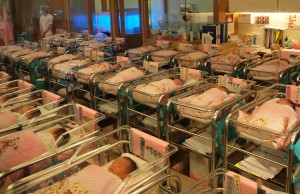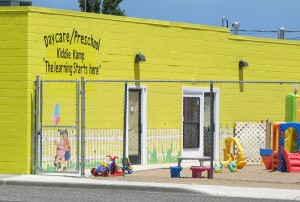Our Youngest Learners: Who Are They and Where Are They Learning?
Every year since 1971, the National Association for the Education of Young Children (NAEYC) has sponsored a weeklong celebration of young children, their teachers, and their families (Week of the Young Child; April 12-18, 2015). This year’s theme is Celebrating Our Youngest Learners.
1971 was a year that seemed to promise a giant leap forward for young learners. The Comprehensive Child Development Act (CCDA), an amendment to the Economic Opportunity Act of 1964 (EOA) Reauthorization, would have provided every American family access to developmentally-oriented child care on a sliding-fee-scale. In September the bill was debated and passed by both the Senate and the House, and on December 2 a final version was adopted by both houses, to be sent to then-President Nixon. But on December 9 President Nixon vetoed the EOA Reauthorization and along with it the CCDA, declaring that the government would not sponsor “communal child-rearing.”
Despite the continued increase in maternal employment and decades of research showing that quality child care benefits children, families, and employers, the US has made almost no progress since the defeat of the CCDA in 1971. U.S. child care continues to falter because its policy goals are not aligned with the needs of contemporary families. One part of the system provides high quality, no-cost early education to children from low income families. The other part functions to support parental employment and is far less well-regulated.
Either way, finding affordable, convenient, and high quality child care that covers parent work schedules and meets children’s developmental needs is a real challenge for most families. Early education programs typically run for only part of the day. The cost of full-time child care rivals that of college tuition in most states. And aside from the federal standards for Head Start programs, regulation of safety, health, and quality varies widely from state-to-state.
Today’s Youngest Learners: What Distinguishes Them and Their Families?

Today’s youngest learners face a novel situation in several respects. In 2013, 3.9 million babies were born in the U.S., marking an all-time low general fertility rate of 62.5 births per 1,000 women aged 15-44. Although the total number of our youngest learners has never been smaller, the diversity of their racial-ethnic and socioeconomic characteristics has never been greater. In 2009, of the 21.3 million children under age 5 years, 74.5 percent were white, 15.2 percent were Black, 4.7 percent were Asian, and 5.6 percent were Native American, Pacific Islanders, or mixed race. About 26 percent of them have Hispanic origins. One in four children under the age of 6 lives in poverty and 14.3 percent are White, 42.3 percent are Black, and 36.8 percent are Hispanic.
In addition, children are now more likely to live in poverty than any other age group. More than half of infants born in 2013 participated in WIC, the federal nutrition program for households earning below 185 percent of the federal poverty level (in FY 2014-2015 = $44,123 for a family of 4).
Meanwhile, children’s parents are working harder than ever. Among mothers with children under age 6, 64 percent are employed, with 72 percent working 35 or more hours per week (BLS, April 2014). And even young children whose mothers are not employed spend an average of 21 hours per week outside of their mothers’ and fathers’ immediate care.
Where Our Youngest Learners Learn
Child care and early education arrangements are as diverse as young children and their families. About 29 percent of children have multiple child care arrangements in a given week. In fact, the average child experiences 5 different child care settings before starting kindergarten.
Some programs for young children have an explicit mandate for early education. Head Start was put in place for families living below the poverty level (in 2015, $24,250 for a family of 4). In 2013, 34 percent of eligible 3- to 5- year olds attended Head Start. Although all Head Start programs follow federal performance standards, only 43 percent of programs are open for more than 6 hours per day.
State-funded preK programs also focus on getting children ready for school and 58 percent have family income eligibility guidelines. Unlike Head Start, preK quality is different from state-to-state. Like Head Start, preK programs mostly operate part-day and part-year. Thus, although these early education programs are available at no cost, neither fully supports the child care needs of most employed parents.

To support employment, parents need to make informal arrangements or enter the vast, private market of child care. Center-based care costs the most. Full-time infant care ranges from $5,496 in Mississippi to $16,549 in Massachusetts. For a 4-year-old, full-time care in the same states costs $4,800 and $12,320 a year respectively. There is some federal investment in child care that supports parents’ employment. It takes the form either of a tax credit to families for child care expenses or as a subsidy to lower income households to cover a portion of their child care expenses. Yet even with these subsidies — which are determined at the state level — poor families spend between 20 percent and 28 percent of their income on child care.
Who Teaches Our Youngest Learners
The child care and early education workforce includes about 2 million people. One million are employed in centers, with 59 percent in child care programs with no Head Start or public school affiliation and 35 percent in Head Start or state preK. The other 1 million are paid caregivers and teachers who work in home-based settings.
Although specially trained and educated caregivers and teachers are the linchpin between program quality and children’s experiences, only the early education part of the system has improved its standards. Since 1998, Head Start classroom teaching staff have been required to earn formal child development-related degrees. As of September 2013, half of classroom teachers need a BA in early childhood education or child development and all teaching assistants need at least a Child Development Associate credential. Of the 53 preK initiatives among 40 states, 57 percent require lead teachers to have a related BA and 28 percent require assistant teachers to have a Child Development Associate credential or equivalent.
Nine states do not regulate home-based providers at all. Of the 42 states that do (includes DC), 14 require a high school diploma or GED and 24 have preservice requirements, such as training in child development. Thirty-nine states require annual training for this group. All states except Idaho regulate child care center teacher and director roles. For child care center directors, 47 states require a high school diploma or GED and 49 states require preservice, most commonly the Child Development Associate credential. For center teachers, 32 states require a high school diploma or GED and 39 states require preservice, most commonly defined as ‘experience’ either alone or in addition to a high school diploma or GED. Almost all states require annual training for center directors and teachers, with the median number of clock hours is 15.
These regulations leave many young children with limited opportunities to interact with and be cared for by teachers with the requisite child development knowledge and skills. Across Head Start, preK, and child care, only 45 percent of all teachers of 3- to 5-year olds have a BA or higher. For those caring for children ages birth to 3 years, only 19 percent have a BA or higher.
Employment in early education and child care pays poorly, even for teachers with a college degree. Among all center-based workers combined, median hourly wage is $10.60, ranging from a low of $9.00 for those with a high school diploma to $14.70 for those with a BA or higher. Median hourly wages are the lowest for people caring for the very youngest children ages birth to 3 years. These wages range from $8.60 (high school diploma or less) to $11.40 (BA or higher). College-educated workers across all parts of the child care and early education system earn far less than comparably educated members of the civilian workforce.
Such low wages are linked with high rates of staff turnover and low continuity of care. Half of all center directors report replacing about 25 percent of staff every year. Staff departure rates are the highest in for-profit child care center chains, where they reach, on average, just over 30 percent.
Current Efforts to Improve Our Youngest Learners Early Care and Education Opportunities

Countries that best meet the needs of their youngest learners and families do so with notable investments in comprehensive, universal services. Sweden, Iceland, Denmark, Finland, France, and Norway all spend at least 1.0 percent of GDP on early childhood services. Five of these 6 countries provide a one-year parental leave at 50 percent of salary and have subsidized and accredited preschool services for at least 80 percent of 4-year-olds. Three of these countries also meet benchmarks for strong professional standards for early childhood teachers and caregivers. At least 80 percent of all center and home-based caregivers who have primary responsibility for the direct care of children have completed an entry-level, “induction” course. And, at least 50 percent of staff in government accredited child care centers have completed a minimum of 3 years of college or university and earned a recognized child development credential.
But we do not have to go abroad to find examples of high quality child care that meets the needs of working families and contributes to children’s well-being. Ironically, the U.S. Military Child Care Program is a model example of the “communal child-rearing” that Nixon decried. The military subsidizes two-thirds of the cost of child care and parent fees are based on a sliding-fee scale. About 200,000 children attend the 800 centers and 3,500 home-based programs, which operate for up to 12 hours a day and are nationally accredited. And 40,000 specially-trained employees earn an average of $15.00 an hour and receive military benefits.
The Military’s program shows that it is possible to have government-sponsored quality, affordable child care that meets children’s developmental needs, supports working families, and gives parents peace of mind during the workday. Had the CCDA not been vetoed in 1971, perhaps all Americans could have access to similar programs. Isn’t it about time?
—
This brief is also available online at: https://contemporaryfamilies.org/ccf-briefing-report-fragmented-child-care/
References
Barnett, W.S., Carolan, M.E., Squires, J.H., Clarke Brown, K. (2013). The state of preschool 2013: State preschool yearbook. New Brunswick, NJ: National Institute for Early Education Research.
Belsky, J., Vandell, D. L., Burchinal, M., Clarke-Stewart, K. A., McCartney, K., Owen, M. T., & NICHD SECC. (2007). Are there long-term effects of early child care? Child Development, 78(2), 681-701.
Child Care Aware of America (2014). Parents and the high cost of child care. Arlington, VA. (www.usa.childcareaware.org).
Child poverty data: http://stateofworkingamerica.org/chart/swa-poverty-figure-7d-poverty-rate-raceethnicity/
Child Trends. Head Start participation rates: http://www.childtrends.org/?indicators=head-start
Cohen, S. S. (2001). Championing child care. New York, NY: Columbia University Press.
GovTrack.us. Tracking the United States Congress. https://www.govtrack.us/congress/votes
Head Start Program Facts: Fiscal Year 2014 http://eclkc.ohs.acf.hhs.gov/hslc/data/factsheets
Laughlin, L. (2013). Who’s minding the kids? Child care arrangements: Spring 2011. Household Economic Studies. Washington, DC: United States Census Bureau.
Macartney, S., & Laughlin, L. (2011). Child care costs in the Current Population Survey’s Annual Social and Economic Supplement (CPS ASEC): A comparison to SIPP. SEHSD Working Paper Number 2011-1. Washington DC: U.S. Census Bureau.
MacDermid, S. (2008). Military child care: A government success story. https://contemporaryfamilies.org/military-childcare-government-success-story/
Morgan, K.J. (2001). A child of the sixties: The Great Society, the New Right, and the politics of federal child care. Journal of Policy History, 13(2), 215-250.
National Association for Regulatory Administration. The 50-state child care licensing study: 2011-2013 Edition (Appendix A and Appendix B) http://www.naralicensing.org/Licensing_Study
National Public Radio (Jan 1, 2015). Military’s preschool program considered a national model. http://iowapublicradio.org/post/militarys-preschool-program-considered-national-model
National Survey of Early Care and Education Project Team. (2013). Number and characteristics of early care and education (ECE) teachers and caregivers: Initial findings from the National Survey of Early Care and Education (NSECE). OPRE Report #2013-38, Washington DC: Office if Planning, Research and Evaluation, Administration for Children and Families, U.S. Department of Health and Human Services.
Nelson, J. R. (1982). The Federal Interagency Day Care Requirements. In C. D. Hayes, (Ed.). Making policies for children: A study of the federal process. Washington, DC: National Academy Press.
Pianta, R. C., Barnett, W. S., Burchinal, M., & Thornburg, K. (2009). The effects of preschool education: What we know, how public policy is or is not aligned with the evidence base, and what we need to know. Psychological Science in the Public Interest, 10(2), 49-88.
Roth, W. (December, 1976). The politics of daycare: The Comprehensive Child Development Act of 1971. Institute for Research on Poverty Discussion Papers (#369-76). Madison, WI: University of Wisconsin-Madison.
UNICEF, The child care transition, Innocenti Report Card 8, 2008. UNICEF Innocenti Research Centre, Florence.
U.S. Census Bureau (June, 2010). Table 10. Resident Population by race, Hispanic origin, and age: 2000 and 2009. http://www.census.gov/compendia/statab/2012/tables/12s0010.pdf
U.S. Department of Agriculture, Food and Nutrition Services. http://www.fns.usda.gov/wic/women-infants-and-children-wic
U.S. Department of Health and Human Services, Administration for Children and Families, Office of Child Care. (2012). OCC Fact Sheet. Retrieved from http://www.acf.hhs.gov/programs/occ/fact-sheet-occ
U.S. Department of Health and Human Services, Centers for Disease Control. (January 15, 2015). Births: Final data for 2013. National Vital Statistics Reports, 64(1), 1-65.
U.S. Department of Labor, Bureau of Labor Statistics. (2014, December). Highlights of women’s earnings in 2013. (Report 1051). Washington, DC: U.S. Department of Labor.
U.S. Department of Labor, Bureau of Labor Statistics. (April, 2014). Employment characteristics of families: 2013. BLS News Release, USDL-14-0658. Retrieved from www.bls.gov/news.release/pdf/famee.pdf
U.S. Department of Labor, Bureau of Labor Statistics. (2011, December). Women in the labor force: A databook (2011 Edition; Report 1034). Washington, DC: U.S. Department of Labor.
United States Senate. Summary of Bills Vetoed 1789 – Present. http://www.senate.gov/reference/Legislation/Vetoes/vetoCounts.htm
Vandell, D. L. & Wolfe, B. (2000). Child care quality: Does it matter and does it need to be improved? Madison, WI: University of Wisconsin, Institute for Research on Poverty (SR #78).
Whitebook, M., Philips, D., & Howes, C. (2014). Worthy work, STILL unlivable wages: The early childhood workforce 25 years after the National Child Care Staffing Study. Berkeley, CA: Center for the Study of Child Care Employment, University of California, Berkeley.
Zigler, E., Marsland, K., & Lord, H. (2009). The tragedy of child care in America. New Haven, CT: Yale University Press.


Comments